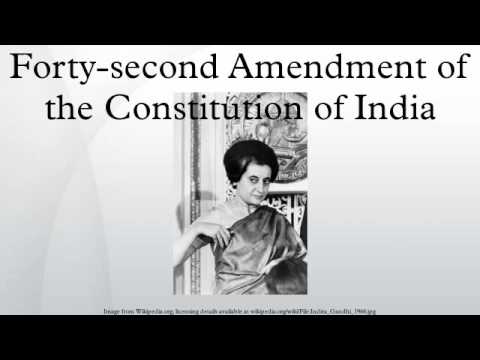Table of Contents
42ND AMENDMENT TO THE CONSTITUTION OF INDIA: AN OVERVIEW
What is 42nd Amendment Act ?
Our Indian Constitution is unique for its content and spirit.. The constituent assembly that was behind framing our constitution has also given possibility for amendments in it with period. Hence, the Indian Constitution of what it’s today has undergone substantive changes on account of several amendments. The act also called The Constitution Act, 1976 is termed together of the foremost controversial acts within the history of amendments to Indian Constitution. It amended/ introduced various provisions given below:
- Attempted to reduce the power of the Supreme Court and High Courts
- Laid down Fundamental Duties for citizens
- Terms- Socialist, Secular, and Integrity were added to the Preamble of India
BACKGROUND
The Emergency period had been broadly shunned, and the 42nd Amendment was the greatest controversial issue. The clampdown on civil liberties and widespread abuse of human rights by police angered the general public . The Janata Party which had promised to “restore the Constitution to the condition it had been in before the Emergency”, won the 1977 general elections. The Janata government then caused the 43rd and 44th Amendments in 1977 and 1978 respectively, to revive the pre-1976 position to some extent. However, the Janata Party wasn’t ready to fully achieve its objectives.
BASIC FACTS OF 42ND AMENDMENT ACT
- The 42nd amendment act was enacted in during the emergency (25 June 1975 – 21 March 1977)
- It was enacted by INC ( Indian national congress) with Indira Gandhi being the head
- It was implied and made in a very dictatorship-manner by Indira Gandhi
- Passed on 11 November by the parliament
- Introduced by : H. R. Gokhale
- Words like socialist was added
- Secular was added
- Integrity was added
BRIEF POINTS OF 42ND AMENDMENT ACT
- Directive principles were added in the 42nd amendment
- New part IV A was added about 10 FUNDAMENTAL DUTIES of the citizens ( Article 51A)
- Parliamentary amendments were done including presidents decision making.
- Judicial review powers were curtailed and many powers were given to the legislative assembly only
- Articles 323A and 323B, Part XIV-A added entitled as ‘Tribunals dealing with Administrative matters’ and ‘Tribunals for other matters’
- Education , Forests Weights & Measures, Protection of Wild Animals and Birds, Administration of Justice , constitution of all courts except HC and SC were transferred from state list to concurrent list in the 7th schedule.
- Termed as Mini-Constitution.
EFFECTS OF 42ND AMENDMENT ACT
During the Emergency, Gandhi implemented a 20-point program of economic reforms that resulted in greater economic process , aided by the absence of strikes and union conflicts. Encouraged by these positive signs and distorted and biased information from her party supporters, Gandhi involved elections in May 1977.However, the Emergency era had been widely unpopular. The 42nd Amendment was widely criticised, and therefore the clampdown on civil liberties and widespread abuse of human rights by police angered the general public
The election ended the control of the Congress (Congress (R) from 1969) over the executive and legislature for the first time since independence After winning the elections, the Moraji Desai government attempted to repeal the 42nd Amendment. However, Gandhi’s Congress party held 163 seats in the 250 seat Rajya Sabha, and vetoed the government’s repeal bill.
The Janata government then caused the 43rd and 44th Amendments in 1977 and 1978 respectively, to revive the pre-1976 position to some extent. Among other changes, the amendments cancelled the 42nd Amendment’s provision that Directive Principles take superiority over Fundamental Rights, and also restricted Parliament’s power to legislate against “antinational activities”. However, the Janata Party was not able to fully attain its goal of reinstating the Constitution to the condition it was in before the Emergency.
CASE LAWS RELATED TO 42ND AMENDMENT ACT
Sections 4 and 55 of the 42nd Amendment were challenged in Minerva Mills v. Union of India, when Charan Singh was caretaker Prime Minister. Section 4 of the 42nd Amendment, had amended Article 31C of the Constitution to accord precedence to the Directive Principles of State Policy articulated partially IV of the Constitution over the elemental Rights of people articulated partially III.
Section 55 prevented any constitutional amendment from being “called in question in any Court on any ground”. It also declared that there would be no limitation whatever on the facility of Parliament to amend the Constitution. After the 1980 Indian election , the Supreme Court declared sections 4 and 55 of the 42nd amendment as unconstitutional. It further endorsed and evolved the essential structure doctrine of the Constitution. In the judgement on Section 4, judge Yeshwant Vishnu Chandrachud wrote:
They are Articles 14, 19 and 21. Article 31C has removed two sides of that golden triangle which affords to the people of this country an assurance that the promise held forth by the preamble will be performed by ushering an egalitarian era through the discipline of fundamental rights, that is, without emasculation of the rights to liberty and equality which alone can help preserve the dignity of the individual New part IV A was added about 10 FUNDAMENTAL DUTIES of the citizens ( Article 51A).
CONCLUSION
The 42nd amendment was termed as a mini-constitution as the changes which were implemented were very much a clear representation of a higher power of parliament and that no judicial review can be applicable on the principles that parliament made that time which gave the parliament powers that were very much Draconian. Even the preamble was changed and the parliament was given powers such as implementation of directive principles without the prioritisation of any fundamental rights. The amendment had many errors but they couldn’t be rectified as judicial interruptions were abolished that time..
Author: Khushi Maheshwari Maheshwari,
Fairfield Institute of Management and Technology

